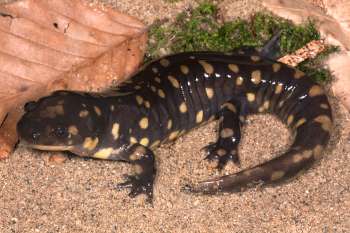Strolling salamanders provide clues on how animals evolved to move from water to land

Around 390 million years ago, the first vertebrate animals moved fromwater onto land, necessitating changes in their musculoskeletal systems to permit aterrestrial life. Forelimbs and hind limbs of the first tetrapods evolved to support moreweight. But what specific mechanisms drove changes in bone function?
The tiger salamander might provide some clues. A new study from a team of scientistsfrom the National Institute for Mathematical and Biological Synthesis (NIMBioS) andClemson University evaluates what mechanisms drive diversity in bone function,providing new insight into the evolution of how tetrapods—the earliest four-leggedvertebrate animals—took their first steps on land.
In order to understand the biology of fossilized animals, researchers often turn to livinganimals with similarities that help model how extinct animals moved. Salamanders areparticularly good organisms for studying how locomotion onto land evolved, as theiranatomy and ecology is similar to the earliest tetrapods.
Bones must regularly withstand a variety of different forces, or "loads," from both thecontraction of muscles and from interaction with the environment. Limb bones inparticular must accommodate some of the highest forces. Fossil records suggest thatthe forelimb and hind limb may have had different functions for walking on land, but thespecific mechanisms that contributed to these differences are less known. Theresearchers wanted to test what factors could have driven diversity in skeletal design inthe evolution of early tetrapods.
The mechanics of bone loading in the salamanders were tested in a variety of ways,including filming the salamanders as they walked across a custom-built platform thatmeasured forces on the limb bones. A comparison of forelimbs and hind limbs and ananalysis of limb joints were conducted. Mathematical models were used to evaluate howthe limb bones were able to withstand the physical demands of walking on land.
To assure a good test, salamanders that turned, stopped or fell on the platform orwalked diagonally, for example, were excluded from the study.The study found that the forelimbs, compared to the hind limbs, had lower yield stresses,higher mechanical hardness, and a greater ability to withstand loads higher than normal.
"These results offer new perspectives in modeling how tetrapods may have taken theirfirst steps onto land, by considering the unique contributions of both the forelimbs andhind limbs, " said lead author Sandy Kawano, a postdoctoral fellow at NIMBioS.
More information: S. M. Kawano et al. Comparative limb bone loading in the humerus and femur of the tiger salamander Ambystoma tigrinum: testing the 'mixed-chain' hypothesis for skeletal safety factors, Journal of Experimental Biology (2015).
Journal information: Journal of Experimental Biology





















